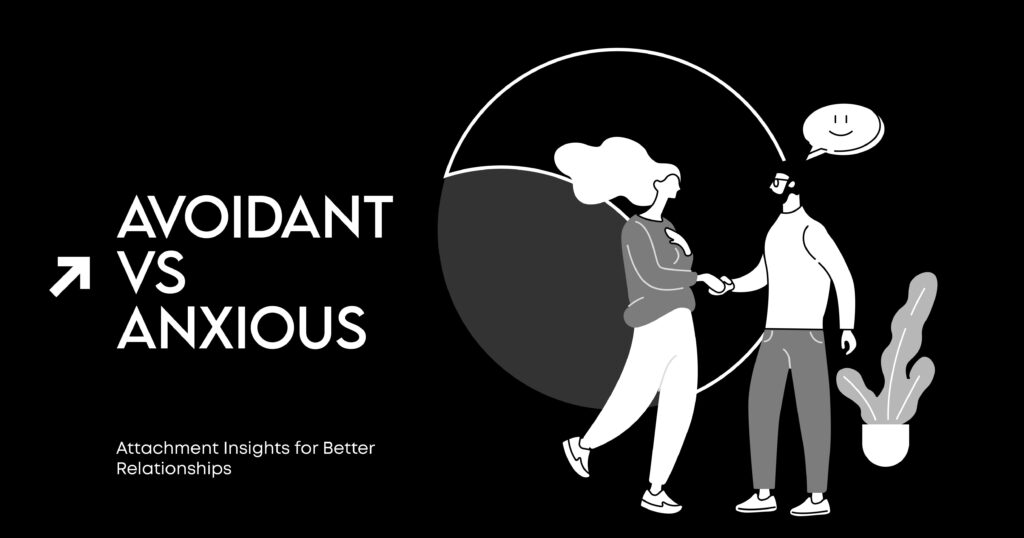Some people back off the moment a relationship starts getting serious. While others lean in hard. They crave constant reassurance? This happens because of attachment styles. They are deep-rooted patterns we picked up early in life. They shape how we connect with others.
Understanding avoidant vs. anxious attachment helps your approach to relationships. It’s like having a map. That explains why you act and react the way you do in your relationships. Not only that, it also makes sense of your partner’s reactions. Especially when things get tense or extra close. Once you see the pattern, it’s way easier to work with it. You’ll stop feeling stuck in the same cycle.
Why Understanding Attachment Styles Matters in Relationships
The last time you and your partner had an argument. Did you find yourself wanting space? Maybe wanting to think things through. Or were you itching to talk it through. Whichever side of the divide you stood, your response wasn’t random. Actually, it was likely influenced by your attachment style.

Here’s why this matters:
- It gives more insight into why some patterns keep recurring in your relationships
- It helps you understand your partner’s needs and fears
- It provides a framework for improving communication
- It offers hope for breaking unhealthy cycles
Understanding attachment styles goes far beyond just learning some fancy psychology theory. You’re actually gaining practical tools that you can apply in real-life situations, and if applied properly, can absolutely transform your relationship with others.
When you understand attachment styles, you’re not just learning psychology theory. You’ve gained a tool that can transform connections with others. Instead of taking your partner’s behavior personally. You can see it through the lens of their attachment needs.
Nashville Mental Health
Avoidant vs Anxious Attachment: Key Differences
In relationship dynamics, avoidant and anxious attachment present differently. To really get how they play out, let’s break down what each one actually looks like.
Defining Avoidant Attachment & Anxious Attachment
Avoidant attachment is like having an invisible shield. This style learned early that emotional needs might not be met. So, they became self-reliant. They value independence. And, often feel uncomfortable with too much closeness.
Anxious attachment, on the other hand, is like having emotional radar that’s always scanning for signs of rejection. These individuals crave closeness but worry constantly about losing their loved ones. They learned that love might disappear, so they hold on tightly.
Characteristics and Causes of Avoidant Attachment & Anxious Attachment
| Attachment Style | Key Characteristics | Common Childhood Experiences |
| Avoidant | Values independence and uncomfortable with intense emotions. | Emotionally unavailable caregivers. Give punishment for showing emotions. |
| Anxious | Seeks constant reassurance. Fear of abandonment. | Inconsistent caregiving. Sometimes responsive, sometimes not. |
Comparing Avoidant and Anxious Attachment
How Each Style Influences Relationship Dynamics
Here’s what typically happens between avoidant and anxious partners:
During Conflict:
- Avoidant partners withdraw, shut down, or minimize the issue
- Anxious partners escalate. Pursue, and want immediate resolution
- This creates a push-pull dynamic that can feel exhausting for both
In Emotional Intimacy:
- Avoidant individuals may feel suffocated by their partner’s emotional needs
- Anxious individuals interpret their partner’s need for space as rejection
- Both styles struggle with finding the “right” amount of closeness
Here are a few communication patterns:
| Situation | Avoidant Response | Anxious Response |
| Partner seems distant | “They need space, I’ll give it to them.” | “Something’s wrong, I need to fix this.” |
| Relationship milestone | May feel pressured or trapped | May feel excited but worried about commitment |
| Emotional conversation | Tends to intellectualize or change the subject | Seeks deep sharing and validation |
| Post-conflict | Moves on quickly, rarely revisits | Wants to process and ensure security |
Trust Issues: The manifestation of trust issues looks different for each style. Avoidant individuals might trust that others will eventually leave, so they protect themselves by not getting too attached. Anxious individuals want to trust but constantly scan for signs that their worst fears are coming true.

Tips for Managing Attachment Styles
The good news is that attachment styles aren’t set in stone! With awareness and effort, you can develop more secure patterns. Here’s how:
For Avoidant Attachment:
- Practice expressing emotions in small doses
- Set reminders to check in with your partner
- Challenge thoughts like “I don’t need anyone”
- Work on staying present during emotional conversations
For Anxious Attachment:
- Develop self-soothing techniques (deep breathing, journaling)
- Practice giving your partner space without panicking
- Challenge catastrophic thoughts about relationship threats
- Build a support network beyond your romantic partner
For Both Styles:
- Communicate your attachment needs clearly
- Practice patience with your partner’s different style
- Focus on building security through consistent, small actions
- Remember that change takes time and compassion
Nashville Mental Health
Therapeutic Approaches for Improving Attachment Patterns
Getting professional help can be a catalyst when you’re trying to build a more secure attachment. It’s more than just about talking through problems; it also involves learning new ways to connect, break old cycles, and heal the things that’ve been weighing you down.
Here are a few approaches people often find helpful:
| Therapy Style | How It Helps | Who It’s Great For |
| Emotionally Focused Therapy (EFT) | Helps couples notice and shift out of those “stuck” patterns, creating stronger emotional bonds | Couples who feel caught in the same arguments |
| Individual Therapy | Digs into old wounds, helps you manage emotions, and rebuilds trust in yourself and others | Anyone wanting personal growth and clarity |
| EMDR | Works through past experiences and trauma that shaped your attachment style | People whose attachment issues are tied to tough memories |
| Mindfulness-Based Work | Builds awareness of your triggers and helps you respond instead of react | Both solo work and relationship growth |
A comprehensive meta-analysis published in PubMed found that patients with secure attachment pretreatment show better psychotherapy outcomes than insecurely attached patients, and improvements in attachment security during therapy may coincide with better treatment outcomes. This research demonstrates that attachment patterns can indeed improve through therapeutic intervention.
Strengthen Your Relationships Through Awareness and Understanding at Nashville Mental Health
Understanding your attachment style is just step one. The real growth happens when you’ve got the right support to help you unlearn old patterns and build healthier ones.
At Nashville Mental Health, our experienced therapists are experts when it comes to helping individuals and couples navigate attachment-related challenges. It doesn’t matter if you’re working through this on your own or as a couple; we’re all about helping you find that more secure, steady energy in your relationships.
Your attachment style doesn’t have to box you in or hold you back. If you’re ready for deeper, healthier connections, this is the sign. Reach out to Nashville Mental Health and take that first step toward relationships that actually feel good and grounded.
FAQs
How do attachment styles influence relationship dynamics and emotional intimacy?
If you’re avoidant, you probably keep people at arm’s length. Closeness feels a little too much. If you’re anxious, you might lean in hard, wanting reassurance all the time.
What are the common communication patterns and trust issues associated with avoidant and anxious attachment styles?
Avoidants usually keep things light, avoid deep talks, and bottle up emotions. While anxious ones do the opposite. They talk a lot, check in constantly, and can get emotional.
How do childhood experiences contribute to the development of avoidant vs. anxious attachment styles?
A lot of it comes from early experiences. Avoidant attachment usually grows out of learning that your needs weren’t going to be met.
What are effective coping mechanisms for managing conflict resolution in relationships affected by these attachment styles?
Taking a breather mid-argument can be a lifesaver. Talking about how you feel with “I” statements instead of pointing fingers helps too. It also makes a huge difference to actually listen and understand what your partner is afraid of instead of just reacting.
Nashville Mental Health
How can understanding avoidant and anxious attachment styles improve emotional intimacy and trust in relationships?
You stop seeing your partner’s reactions as personal attacks. Instead, you start to understand the fears behind them. That makes space for more compassion and deeper talks.





